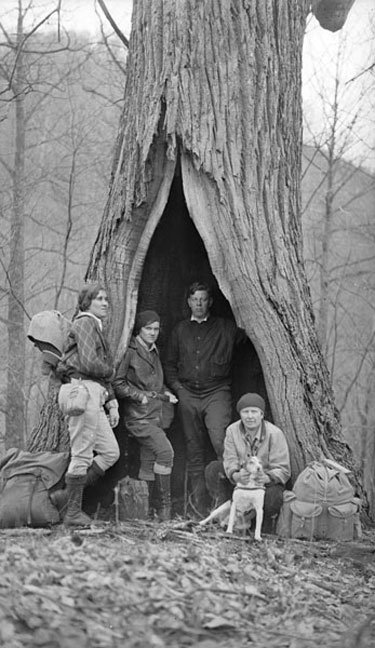Giant Trees of Appalachia
Appalachia, Trees, West Virginia
Some Dark Hollow reminds us that there used to be giant trees, big enough for people to live in their hollow bases, right here in the Eastern United States, not only in California.
According to the Encyclopedia of West Virginia, the largest trees ever documented in the eastern states were three sycamores documented by George Washington in 1771 on the Three Brothers Islands in the Ohio River. Washington was amazed at the size of these trees and estimated in his diary that one of them was 61 feet in circumference at its base! …
• In 1750, explorers Jacob Marlin and Stephen Sewell headed westward across the Allegheny range and found there way to where the mouth of Knapps Creek empties into the Greenbrier River in what is now Pocahontas County, WV. The two men decided to settle in the area. They built a cabin in for themselves, but ended up having a falling-out. Their quarrel eventually reached a point where they were not speaking to each other. So Sewell moved to a large hollow sycamore tree which stood a short distance from the cabin and lived there for a period of time.
• The following year, when surveyors for the Greenbrier Land Company entered the area, they found Marlin and Sewell living quite happily in their separate dwelling places. It was also reported that each morning the two men greeted each other with pleasant salutations. After Sewell moved on farther west where he was later killed by Indians, his former sycamore tree house served as a temporary dwelling place for many others who passed that way in subsequent years and remained as a landmark until 1930.
• Another hollow sycamore tree story from West Virginia took place near Buckhannon in Upshur County. In 1761, during the French and Indian War, John and Samuel Pringle, with two other British soldiers, deserted the army at Fort Pitt and hid out in the wilderness of the Youghiogheny River Valley. The next year when the other two soldiers were arrested, the Pringle brothers moved southwestward into the Monongahela Valley where they worked with a trapper by the name of John Simpson until 1764. After having a quarrel with Simpson, the Pringles moved into the Buckhannon River Valley and at the mouth of Turkey Run they made their home in a large hollow sycamore tree.
They lived there for about three years, until their supplies ran low and John set out to replenish them. He returned seven weeks later with the news that the war had come to an end. No longer concerned about being arrested for desertion, the brothers decided to return to the eastern settlements where they hoped to recruit others to come settle the Buckhannon Valley with them. The next year, Samuel Pringle, with his new bride and several other people, came and established the first permanent homes in this valley and, for a time, Samuel and his wife made their home in the hollow sycamore tree.
The giant chestnuts are gone in Pennsylvania, killed by the blight, but I know several places where you can see original first growth trees still standing.





